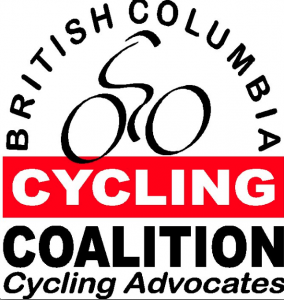BLOG #2
British Columbia Cycling Coalition (BCCC)
The organization that our group will be working with is the British Columbia Cycling Coalition (BCCC). BCCC is a non-profit organization thats founded in 1998, its main office is located at Vancouver, British Columbia. The society has a clear division of labour which consists of at least 5 directors and the president of the BCCC is elected by the general members. As long as you are a cycling advocate, you can be a member of the society.
The purposes of BCCC mainly include representing the interests of cyclists in BC, ensuring their interests were recognized, and serves to support cyclists and relate organizations in BC and across Canada.
The vision and goals for BCCC are, to promote principle that the bicycle is a legitimate vehicle and is an integral part of the transportation system and encourage more cycling so that people can realize the “virtue of cycling”. Ultimately, a happy, healthy, and sustained community can be established.
Project Scope
The project is aimed at researching and analyzing the effects of traffic devices, specifically shoulder rumble strips (SRS) on cyclists. We hope to provide a detailed report that would address the issues voiced by the BC Cycling Coalition and improve provincial cycling conditions.
Our research will focus on a number of areas including:
- circumstances that SRS would be effective and/or ineffective traffic safety devices
- SRS safety and/or hazard effects on cyclists
- solutions (alternate devices) to mitigate the negative effects on cyclists while preserving the same safety measures by SRS
- possible effects of “centerline” rumble strips on bicycle/motor vehicle interactions
- examples of how past jurisdictions have handled this issue and how it can apply to BC roads
- how solutions can be integrated into our transportation planning process.
We will also investigate if the installation of rumble strips would generate a degradation of pavement quality, especially on shoulders.
Negotiable and non-negotiable constraints will be developed later on, in consultation with the client.
Strategies
For this project, we have thought about several strategies to aid us in completing this project most efficiently. Our strategy is to first look at the “big picture” of this project, including its scope and constraints to get an idea for how each part of this project fits together. Next, we will divide sections (that are possible to divide) and split up our work in an equal manner, and using each member’s strengths most effectively. By working in this fashion, we ensure that our skills are being used to their full potential and that the work is orchestrated in an organized manner. Furthermore, we have created a group on Facebook to easily communicate with one another and a Google Docs page to collaborate information without the need for appointing meetings. By using these strategies, we will make the most effective use of our time during this CBEL project.
Authors: Shibo Li, Tony Zhang, Jason Chen, Luke Minosky, Sunny Hon, Qianyuan Li
Blog entry created: Feb. 1


Hi Team,
This is a really important project! When are you planning to meet with the client?
I suggest that you start now to put together the template for the report, including the report section headings and what you plan to put into each section. Do you have a time-line yet for project completion?
Where is the image for this post? Please remember to include an image in post #3! 🙂
Regards,
SN
Hi Dr.Nesbit
We are planning to meet our client early next week.
The picture did show up last time was due to some computer issues, now it is fixed.
Thanks for your suggestion and we will get things together very soon
Regards,
Robin